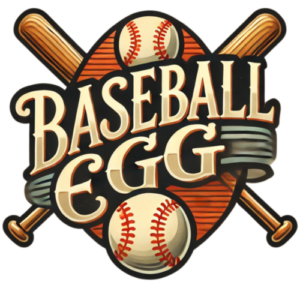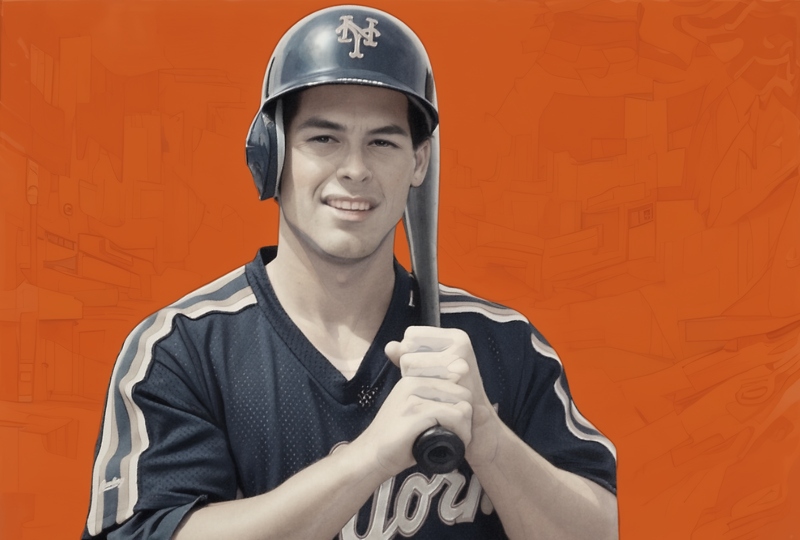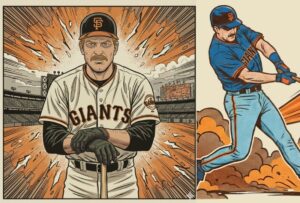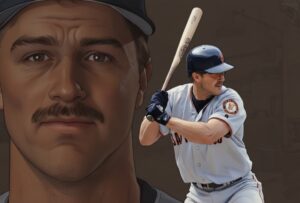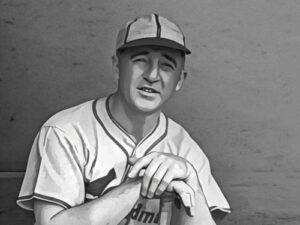“Gregg could hit .300 standing on his head.” — manager Davey Johnson
Through age 27, Jefferies had more hits than Rod Carew and Paul Waner. He had as many RBI as Mike Schmidt through the age of 27. In his age 25-27 seasons, Jefferies batted .325 with 13 homers and 22 stolen bases per season. He was basically Paul Molitor Lite. But his projected superstar status never materialized, and in the end, despite a good career, Jefferies is considered a disappointment judged against the potential he showed as a young player.
Jefferies was selected with the 20th pick in the first round of the 1985 MLB Draft by the Mets. Many consider that draft the best in history, with Barry Bonds, Randy Johnson, Barry Larkin, Will Clark, Rafael Palmeiro, David Justice, and Jefferies among the future All-Stars who were picked in that draft.
Baseball America named Jefferies Minor League Player of the Year twice, the first player to be honored multiple times. He made his debut with the Mets at the age of 19 in 1987. The following season, Jefferies batted .321 in 29 games during a late season summons to Queens. In the 1988 NL Championship Series, Jefferies hit .333 in seven games. He was such a great young hitter that the Mets had to find a position for him on their talented team. That’s why they traded second basemen Wally Backman after the 1988 campaign.
A switch-hitter, Jefferies had a short swing that emanated from a slight crouch at the plate. He had a longer than normal stride with his lead right leg. He looked a lot like Don Mattingly from the left side of the plate. Jefferies had success against many of the best pitchers in baseball: he batted .341 against Greg Maddux; and .469 in 32 at-bats against Pedro Martínez. Because he made contact and was a tough out from both sides of the plate, he was compared to Pete Rose.
Jefferies was unflinchingly confident. He had a colorful personality: he loved Elvis Presley, he was a handsome kid from northern California, and he rubbed his bats down with alcohol after each game. His father, a high school baseball coach, imbued his son with the skills and moxie to succeed. He famously had his son swing a bat in the swimming pool to improve his strength and mechanics.
The 1980s Mets were probably the worst possible team for Jefferies to break in with. The team won the World Series in 1986, and had oodles of talent on the roster. But unfortunately, the clubhouse was teaming with petty people with egos the size of New York pizza boxes. There were three or four factions in the Mets’ clubhouse, each with a strong-minded player at the top of the hierarchy. Keith Hernandez led the group that considered themselves the guardians of the unwritten rules of baseball. One of those was that rookies were meant to be seen and not heard. The heralded ‘can’t miss prospect” Jefferies had a target on his back before he ever earned a starting position on the club.
As a rookie, Jefferies wasn’t interested in carrying bags for the veterans, or running errands. He wanted to spend time watching film of his at-bats, or hitting balls off a tee. His obsession, and the inches of print Jefferies got in the tabloids, rubbed Hernandez and others the wrong way. Darryl Strawberry, the team’s biggest superstar and a drug addict, basically refused to acknowledge the “next great Met.” In his years with the team, Jefferies was the topic of ridicule by many of his teammates.
Jefferies was so good (he hit .343 in the rookie league when he was 18; .339 in Class-A ball; and .367 in Double-A), the Mets placed Howard Johnson on the trade market. But eventually, manager Davey Johnson, a former Gold Glove second baseman, shepherded “The Kid” into his new position at the pivot. Several players never forgave Jefferies for being so well regarded that Backman was traded.
The distractions didn’t bother Jefferies initially. In 1988 when he was called up in late August after hitting .282 for triple-A Tidewater, he went 5-for-9 with two doubles, a triple, and a home run in his first two games. But he preferred third base, and that’s where the problems began for him and the Mets. Jefferies was unfairly asked to learn a difficult defensive position on the fly at the big league level. Some players on the team were delighted when the prodigy failed.
“It was the roughest group to break in with, the Mets of that era [were as] tough as they come,” said pitcher David Cone. “We self-policed, and we ran rookies hard. It was a different generation of players. The veterans were hard on [Gregg]. Once you were on the wrong side with that group it was impossible to recover.”
In 1989, the first season he went north with the Mets, Jefferies struggled at the plate for the first time in his professional career. He heard boo-birds at Shea, and whispers from some teammates that he was a bust.
“I took [every loss] to heart,” Jefferies said. “I blamed myself for every defeat… I had gotten into bad habits and was swinging at bad pitches.” On June 6, Jefferies was hitting .182 with zero home runs.
Jefferies was benched for two weeks, and when he returned Johnson inserted the typical No. 2 hitter in the leadoff spot. He batted .319 with eight of his 12 home runs hit after August 1. Some people thought he should win Rookie of the Year and Comeback Player of the Year in the same season. But his fine season ended with controversy.
In the Mets’ final home game of 1989 they faced the Phillies.* Jefferies came up in the ninth with two outs to face reliever Roger McDowell, a former teammate who had reportedly been part of a group of players who envied Jefferies and the attention he got. Jefferies sent a broken-bat grounder to second base. McDowell shouted something at Jefferies that wasn’t appreciated, which prompted the Met to bolt for the mound. With the game over, Jefferies body slammed McDowell to the ground, and received a few short punches to the face in the process. It was later alleged that the pitcher told Jefferies to “shove that bat up your ass.”
In 1991, Jefferies became embroiled in the type of controversy that often permeated the Mets of that era. Pitcher Ron Darling “leaked” his misgivings about the Mets’ infield defense to a sportswriter. Allegedly, Darling named names, but misspelled “Jefferies” in his gripe. In response, Jefferies allegedly fired off a handwritten letter to the media, in which he is reported to have said, “all too often I have been criticized and blamed by some of my teammates.” He went on to write, “I can only hope that one day those teammates who have found it convenient to criticize me will realize that we are all in this together. If we can only concentrate more on the games, rather than bickering and pointing fingers, we would all be better off.” Jefferies also defended himself, pointing out that he had not made the decision to be placed at second base, and it wasn’t him who anointed himself as the next great Met superstar.” The letter (which Jefferies later claimed to have not written) only served to alienate him further from his teammates and fans.
The 1991 season was the first losing campaign for the Mets since 1983. It was also the first post-Johnson season. Those facts and the Jefferies Letter prompted the team to trade Gregg in the offseason. At the winter meetings in December, Jefferies, Kevin McReynolds, and a third player were dealt to the Royals for pitcher Bret Saberhagen and an infielder. Jefferies, once “The Chosen One,” was no longer a Met.
The Royals handed the third base job to Jefferies. He held that position for only one season. In 1992, Jefferies played 152 games and made 26 errors. The miscues, most of them erratic throws across the diamond, were too much for the shortsighted Royals, who apparently couldn’t remember when George Brett played the hot corner with just as much sloppiness. There were also rumblings that Jefferies and KC manager Hal McRae had a personality clash. The Royals traded Jefferies to the Cardinals before the 1993 season, essentially straight-up for Félix José, a terrible defensive right fielder.
Jefferies was still only 25 when he played his first game for St. Louis. The Cardinals made him a first baseman, and for the first time in his major league journey, Jefferies didn’t have to worry about playing a different position. He banged out 112 hits in the first half, for a .343 average with 12 home runs and 27 steals (he finished with 46). He was a legitimate MVP candidate. He made his first All-Star team, finished third in the NL batting race, and 11th in the MVP balloting. The next season he had his average over .380 in May, had a 17-game hitting streak, and was an All-Star again.
The two outstanding seasons for the Cardinals came at the right time: Jefferies became a free agent in November of 1994. The next month, he signed a four-year, $20 million contract with the Phillies. His new team intended to bat him third (behind Lenny Dykstra and ahead of Dave Hollins) and play him in left field. Jefferies welcomed the challenge of fitting in with the notoriously hard-nosed Phils. “I have already bet Lenny that I will get my uniform dirtier than he’ll get his,” Jefferies said.
In Philly, Jefferies fell short of expectations, batting .287 with a 97 OPS+ in four seasons. Like with the Mets and Royals, he found himself criticized by his own team. Catcher Darren Daulton allegedly coined the nickname “Chardonnay” for Jefferies because of all the whining he did about balls and strikes. His histrionic helmet-throwing also fell flat with a fan base notorious for being impatient and harsh.
At the trade deadline in 1998, the final year of his contract with the Phils, Jefferies was sent to the Angels. On a playoff contender for the first time in years, he immediately perked up. In his first six games with the Halos, the switch-hitter went 14-for-27 and drove in eight runs. He batted .347 down the stretch, but the Angels missed the playoffs.
Gregg Jefferies was only 31 when he signed a free agent deal with the Tigers after the 1998 season. He had more than 1,500 hits, 118 home runs, nearly 200 stolen bases, and a .292 career average. In theory he should have had many years left. But for some reason, Baseball’s Father Time came for Jefferies early. In Detroit, he got off to an abysmal start, and despite a good showing in the first few weeks of his second season as a Tiger, his quick bat slowed to a slow chug. The highlight of his two seasons in Detroit was appearing in the final game played at Tiger Stadium.
Following the 2000 season, Jefferies was unsigned, yet still only 33 years old. He was a man without a position: and as a designated hitter, his power numbers and low walk rate made him undesirable. He had made about $30 million in baseball, and when his phone didn’t ring that winter, the former All-Star faded into retirement. Detroit manager Phil Garner offered Jefferies a job as his bench coach, but Gregg declined. He later worked as a private hitting coach in California. He also mellowed on his tumultuous years as a Met phenom.
“That was the era. It’s not their job to coddle me,” Jefferies said. “[My Mets’ teammates] had enough pressure on their plate. You don’t think Keith Hernandez, Darryl Strawberry, and Gary Carter had pressure? They were the faces of New York. Thay had their own issues. I needed to take care of [myself]. I had to learn as I was playing.”
